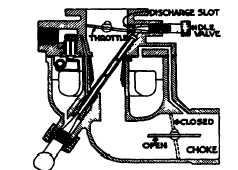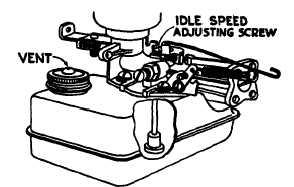TM 5-4240-501-14&P
THEORIES OF OPERATION
Carburetion
The idle valve chamber leads into the carburetor throat
above the throttle. Here the pressure is low, and the fuel
rises in the nozzle past the idle valve and into the
carburetor throat through the discharge slot. The
amount of fuel is metered by turning the idle valve in or
out until the proper mixture is obtained. Here again we
see what happens if the needle is screwed in too far. A
damaged idle valve can result.
Adjustment of the idle valve is similar to that of the
needle valve but should be made after the needle valve
has been adjusted. The idle speed is not the slowest
speed at which the engine will run. On small engines it is
1750 RPM. On larger engines the idle speed may be as
low as 1200 RPM. Use a tachometer to set the speed.
Turn the idle speed adjusting screw (located on throttle
shaft) until the desired idle speed is obtained and hold
throttle closed. Turn the idle valve in until speed
decreases, then out until speed increases and again
decreases. Then turn the idle valve to a point midway
between these two settings. Usually the idle speed
adjusting screw will have to be reset to the desired idle
speed.
Figure 18.
The next problem is starting the engine in different
temperatures and with different fuels. A butterfly,
mounted on a shaft, is placed in the air horn. With this
choke we can close, or almost close, the air horn and get
a low pressure area in the venturi and throat. See Fig.
18.
Thus, a rush of fuel is obtained from the nozzle with a
relatively small amount of air. Even with low vaporization
this extra rich mixture will give easy starting. Only a
portion of the fuel will be consumed while choking, and a
large portion will remain in the cylinder. This raw
gasoline will dilute the crankcase oil and may even cause
scuffing due to washing away of the oil film from between
the piston rings and the cylinder wall. For this reason,
prolonged choking should be avoided.
This now is our complete carburetor.
VACU-JET CARBURETORS OR
SUCTION FEED
Now let us take a look at the Vacu-jet or suction feed
system. Here the fuel tank is below the carburetor, so
obviously the fuel will not flow by means of gravity.
Therefore, the force of atmospheric pressure must be
employed.
Figure 19.
Again we have a vent hole in the fuel tank cap to allow
the pressure in the tank to remain constant. Now here is
something important. Before adjusting the carburetor
pour in enough fuel to HALF fill the tank. The distance
the fuel has to be lifted will affect the adjustment. At half
full we have an average operating condition, and the
adjustment will be satisfactory if the engine is run with
the tank full or nearly empty.
As the piston goes down in the cylinder with both the
intake valve and the throttle open, a low pressure area is
created in the carburetor throat. A slight restriction is
placed between the air horn and the carburetor throat at
the choke. This helps to maintain the low pressure.
The difference in pressure between the tank and the
carburetor throat forces the fuel up the fuel pipe, past the
needle valve, through the two discharge holes. The
throttle is relatively thick, so we have, in effect, a venturi
at this point, thus aiding vaporization. A spiral is placed
in the throat to help acceleration and also to help keep
the engine from dying when the throttle is opened
suddenly.
The amount of fuel at operating speed is metered by the
needle valve and seat. Turning the needle valve in or
out changes the setting until the proper mixture is
obtained. This adjustment must always be done while
the engine is running at operating speed, not at idle
speed. While the needle valve may look like an idle
valve due to its position, it is a true high speed mixture
adjusting valve.
10
4



